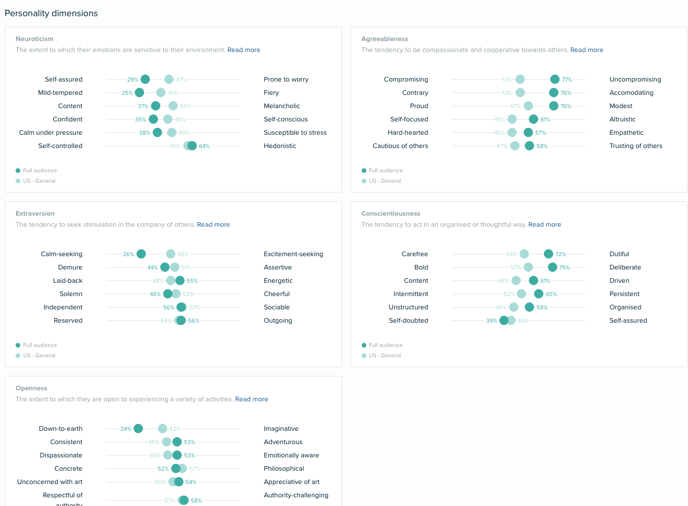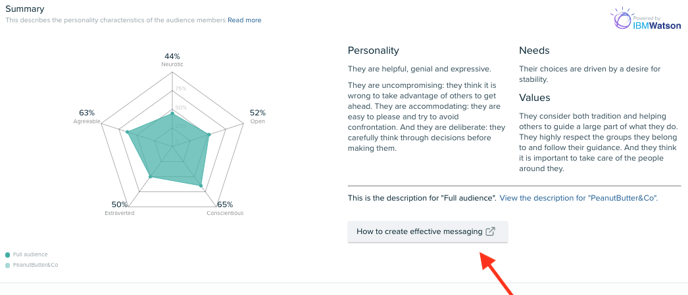Personality Insights uses the power of the IBM Watson (AI) to deliver rich insight into audiences. Personality Insights are a great way to understand your audience’s intrinsic characteristics to create a tone of voice your audience will respond to, useful when creating an ad or campaign.

Personalities are broken down using three models: The Big Five OCEAN Personality Type, Needs and Values.
- These are the five primary dimensions that can be attributed to a person: Openness, Conscientiousness, Extraversion, Agreeableness and Neuroticism (forming the acronym OCEAN). From this, each dimension can be broken down into six facets to further characterize an individual. In this case, each segment within your audience would embody specific personality dimensions.
-
- Openness is the extent to which a person is open to experiencing different activities.
- Conscientiousness is a person's tendency to act in an organized or thoughtful way.
- Extraversion is a person's tendency to seek stimulation in the company of others.
- Agreeableness is a person's tendency to be compassionate and cooperative toward others.
- Neuroticism, showing emotional range or natural reactions, is the extent to which a person's emotions are sensitive to the person's environment.
- Needs describe which aspects of a product are likely to resonate with a person. The model includes twelve characteristic needs: Excitement, Harmony, Curiosity, Ideal, Closeness, Self-expression, Liberty, Love, Practicality, Stability, Challenge, and Structure.
- Values describe motivating factors that influence a person's decision-making. The model includes five values: Self-transcendence / Helping others, Conservation / Tradition, Hedonism / Taking pleasure in life, Self-enhancement / Achieving success, and Open to change / Excitement.
Personality Insights is based on the psychology of language in combination with data analytics algorithms.
The process
We filter the tweets from each member within the audience. To get the best quality, we discard retweets as these have not been written by the author; only the quality ones are sent to IBM Watson. IBM Watson will then analyse these tweets based on natural language and score them against each personality trait.
When an audience scores, it does not mean that only x% of that audience is of that trait. It shows that they score x/100 intensity of that trait. For example, this audience on average scores 44 in the neuroticism trait. This means that on a scale of 1-100, they score 44 out of 100, the most extreme of the neuroticism trait. Use this number to compare against a baseline to show which is more relevant and unique for that audience.
Compare your audience with a baseline - some examples:
a) Segment compared to the full audience (identify what makes this segment unique)
b) Full audience compared to a country national average or global (users on Twitter in a specific country, or global)
c) Segment compared to another segment
d) New report (full audience/segments) compared to an older report (periodic changes in data when using same audience definition)
Personality dimensions
Below the main Personality summary on this tab, you will find the data broken down into each ‘Big Five’ personality dimension and its 6 facets that make up this personality trait.
If you hover over the terms, it will display what these criteria actually mean. To interpret this data: when the number is lower (below 50%) on the scale, it scores on the left, and higher (than 50%) it scores on the right. This list will be ordered depending on the difference with the baseline.

What drives them?

How to activate these insights:
Effective Messaging for Personality types
We offer Personality-based recommendations for effective messaging, in terms of tone-of-voice, aesthetics, semiotics, language and brand position. You can download our PDF Effective Messaging guide, which provides recommendations on each extreme represented in the Big Five OCEAN personality types (high and low %) via the grey button shown below the summary overview.

.png?width=688&name=Screenshot%202021-09-23%20at%2013.04.23%20(2).png)
How to interpret the % (High or Low)
To establish the leading trait (which High or Low to focus on), we would be finding the one that is closer to 0 or 100, or whatever is bigger when you take 50 out of each in this example:

O 52 - 50 = 2
C 65 - 50 = 15
E 50 - 50 = 0
A 63 - 50 = 13
N 44-50 = -6
The winner is High Conscientiousness
(the highest score when we make the calculation)
IBM Watson further reading (PDFs):
Personality Insights Dimensions Characteristics - Table
Personality Insights Facet Characteristics - Table